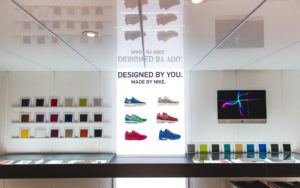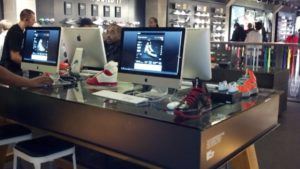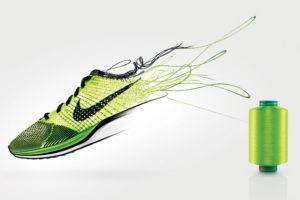NikeID: polishing the shoe buying experience

How did modern technology allow Nike to revolutionize the way sneakers are designed, produced and distributed ? Can it be economically viable to give the end consumer the control over the design of the shoes they want to wear ?
Originally used for the sole purpose of physical exercise, sneakers have now become the most ubiquitous type of shoes worn globally. The democratization of sport shoes globally can largely be attributed to Nike. Started by Phil Knight, in the back of his truck in Oregon in 1964, Nike has emerged as the leading actor in the sport shoe business, totalling 63.000 employees globally and generating $31B in sales and $3.2B in Net Income in 2015. {1}
 Despite the revolution in terms of scale that the market has seen over the last five decades and the necessary changes in logistics that it required for global players, no revolution has brought more innovation to the operating model of shoe manufacturing than NikeID. For decades, the selection of colours was limited for each design, with most of the shoe coming either in black or white. At a time where customers are more and more looking for customization and differentiated items, Nike has introduced a game changing platform to change the way sport shoes are bought. {2}
Despite the revolution in terms of scale that the market has seen over the last five decades and the necessary changes in logistics that it required for global players, no revolution has brought more innovation to the operating model of shoe manufacturing than NikeID. For decades, the selection of colours was limited for each design, with most of the shoe coming either in black or white. At a time where customers are more and more looking for customization and differentiated items, Nike has introduced a game changing platform to change the way sport shoes are bought. {2}
How did modern technology allow Nike to revolutionize the way sneakers are designed, produced and distributed ? Can it be economically viable to give the end consumer the control over the design of the shoes they want to wear ?
 Originally launched in 1999, NikeID is a service allowing customers to design and customize their own nike shoes. Initially launched as an online service only, NikeID soon made its way to physical Nike retail stores as “stores-in-stores” where users could customize their shoes with the help of the Nike sales representatives. In 2012, with the increase of m-commerce, Nike release mobile apps allowing the end consumers to design and purchase their shoes directly from their smartphones. {2}
Originally launched in 1999, NikeID is a service allowing customers to design and customize their own nike shoes. Initially launched as an online service only, NikeID soon made its way to physical Nike retail stores as “stores-in-stores” where users could customize their shoes with the help of the Nike sales representatives. In 2012, with the increase of m-commerce, Nike release mobile apps allowing the end consumers to design and purchase their shoes directly from their smartphones. {2}
This groundbreaking innovation marked the end of an era of “monolithic” operational model where manufacturers had to anticipate the overall demand for each SKU, colour and size, manufacture overseas and distribute across markets. With NikeID, Nike would first find a way to increase the “Direct To Consumer” channel that is so strategic to them due to higher margins, as the middlemen (the retailers) get cut. Rolling out NikeID and expanding the program to their physical stores would be a very differentiated selling points for customers around the world. The promise of wearing customized shoes would also justify the user to pay a price premium on the shoes they buy through the NikeID channel. According to Forbes, Nike has been able to raise their “Direct to Consumer” sales from 22% of total sales to 30% in 2015, growing their overall margin by 1.4% year on year (from 2014 to 2015),with NikeID being a strong driver of this growth. With e-commerce representing a mere 20% of the “Direct to Consumer” sales, NikeID has a lot of room to grow and has a very strategic role to play in Nike’s future development. {3}
 Besides, by adopting this differentiated operations model where “Just in Time production” and “demand flow technologies” are replacing a heavy and cumbersome traditional demand and planning and production process, Nike has found a way to exponentially increase the number of SKUs they can offer at a very limited incremental inventory and raw material cost.s The raw material used for the customized sneakers are not dramatically different from the ones used for the “traditional sneakers” manufacturing. The main difference lies in the combinations made possible to the user who can choose between dozens of colours and textures for each of the components of a specific shoe. The beauty of the NikeID model lies in the fact that Nike is only marginally sacrificing the economies of scale that its regular business enjoys when purchasing raw materials. New designs are now increasingly engineered to be easily customizable, as is demonstrated by the recently released range of Nike FlyKnit shoes. {4}
Besides, by adopting this differentiated operations model where “Just in Time production” and “demand flow technologies” are replacing a heavy and cumbersome traditional demand and planning and production process, Nike has found a way to exponentially increase the number of SKUs they can offer at a very limited incremental inventory and raw material cost.s The raw material used for the customized sneakers are not dramatically different from the ones used for the “traditional sneakers” manufacturing. The main difference lies in the combinations made possible to the user who can choose between dozens of colours and textures for each of the components of a specific shoe. The beauty of the NikeID model lies in the fact that Nike is only marginally sacrificing the economies of scale that its regular business enjoys when purchasing raw materials. New designs are now increasingly engineered to be easily customizable, as is demonstrated by the recently released range of Nike FlyKnit shoes. {4}
Nike mentions that customized shoes required between four to six weeks to be delivered to the end customer in the US {7}. While this can appear as a long time, the customization of the shoe provides a valid enough for the consumer to accept such a long timeframe.
More than a gimmicky addition to Nike’s ecommerce strategy, NikeID now generates a “significant revenue and a large portion of our total e-commerce business,” says Ken Dice, Nike’s Vice President of NikeiD. Similarly, other brands like Converse (also owned by Nike) have recently launched their online customization platform {5}. Following Nike’s success, luxury brands like Burberry, which launched Burberry Bespoke, have adopted this same strategy to grow their “Direct to Consumer” sales and increase their margins. {6}
757 words
SOURCES:
{1} Nike Financials: http://investors.nike.com/investors/news-events-and-reports/?toggle=earnings
{2} Financial times: http://www.ft.com/cms/s/0/28e6319a-8f30-11dc-87ee-0000779fd2ac.html?ft_site=falcon&desktop=true#axzz4QIDS0Zqe
{3} Forbes: http://www.forbes.com/sites/greatspeculations/2015/07/09/how-nikeid-is-helping-nikes-push-for-greater-profits/#2318d14c48b7
{4} Bloomberg: http://www.bloomberg.com/news/articles/2012-03-15/is-nikes-flyknit-the-swoosh-of-the-future
{5} Business of Fashion: https://www.businessoffashion.com/articles/intelligence/mass-customisation-fashion-nike-converse-burberry
{6} Harvard Business Review: https://hbr.org/2013/01/burberrys-ceo-on-turning-an-aging-british-icon-into-a-global-luxury-brand
{7} Nike website: http://help-en-us.nike.com/app/answers/detail/a_id/1443/~/personalization-policy-for-nikeid-products



Fascinating article! I’ve never used NikeID, but I’m curious to try it, especially with Black Friday / Cyber Monday around the corner.
I agree with your point that NikeID offers huge value to customers by giving them access to so many more design options than they would traditionally receive. NikeID also elevates the brand beyond athletics, into an enviable fashion brand. This presents a huge opportunity for Nike, especially with the rise of “athleisure,” a category of apparel catered to consumers looking for clothes that are durable enough to wear while training and fashionable enough to wear day-to-day. Thus far, it seems that Nike’s strategy of cultivating a fashion following has succeeded. According to the NYT, Nike was the most Instagrammed fashion brand of 2015, garnering ~48M hashtag mentions (2.5x Prada, the second most Instagrammed brand).
Source: http://www.nytimes.com/2016/03/17/fashion/nike-fashion-olympics.html?_r=0
BFM – It is amazing to see how producers of consumer goods are relying on new business models to preserve margins in light of increased competition across sales channels. You make the point that Nike can “increase the number of SKUs offered at a limited incremental inventory.” This causes me to wonder what type of long-term impact the shift to Nike ID sales will have on its bottom line?
I ask this question because as Nike continues to innovate and offer new styles there might be a higher chance that the Company’s raw material inventory will become obsolete at a faster pace. This problem has started to emerge in its recent earnings calls. Management has stated that its gross margin had declined 30 basis points due to write-offs in excess inventory [1]. I assume that the thousands of iterations in color, materials, and sizes required by the Nike ID store will contribute to higher variation in the procurement of raw materials. This will create a unique challenge to Management, testing their ability to balance lean inventory with expanded offerings. Is there anything they can do to help mitigate this problem? Two simple solutions could be reducing the total number of product lines and leveraging past material patterns for future products. Would this compromise the Company’s strategy of constant innovation?
[1] http://www.businessinsider.com/nike-is-facing-problems-2016-6
BFM, this was an awesome post. I have used NikeID a few times, and I always thought it was a really cool way for customers to interact with Nike in a very unique way, but I had never thought before about how innovative NikeID really was and continues to be.
Per Tim’s comment above, it seems like designing shoes and other customizable products with consumer customization in mind is going to be increasingly important for Nike to maintain profitability and inventory control. Has Nike significantly altered its product offering to better manage the NikeID phenomenon? It will be interesting to see if other fashion brands and even completely unrelated industries continue to pursue customization.
BFM – amazing post! As a consumer of Nike and NikeID, I’ve always loved the customized product. Not only did Nike make customizing easy for consumers, but they also did a great job of incorporating tech into their nike and nikeID product by allowing users to track their run. By uniting technology and function, Nike created a new usage for the shoe and made the product even stickier. Nike became even more synonymous with working out, athletics and living a fit lifestyle. I wonder if Nike is going to be able to maintain its edge against competitors as more tech-enabled workout products and performance tracking products are introduced by existing competitors and new market entrants.
This is a fascinating post. I have heard of but never really used Nike ID. I believe it is the differentiating factor in a market that every now and then sees a newcomer organically pioneer trends, Under Armour for example. The size and scale of Nike itself acts as a barrier to entry to many firms, companies and designers looking to enter the market. I therefore firmly believe that Nike ID is the way of the future in a market being led by m-commerce and where consumers are getting increasingly picky about their brands. Having said which, I don’t see Nike actively promoting Nike ID. Being able to customize a pair of shoes should be a good enough selling point for Nike. Any reasons you think they’re not actively engaging in marketing it aggressively?
Great post and I have to say I really have a lot of respect for Nike being progressive and forward thinking. We have seen it often with many businesses that are the industry leader that they become complacent and rigid but obviously Nike still believes in pushing the envelope. Nike does not want to go down in history as a Kodak who was disrupted. What strikes me as the most interesting thing about this strategy is that Nike has figured out a way to perform customization but without changing the cost structure too drastically. Many times it can be tough for a company to deliver a customized service or product without either compromising margins or raising price but it seems like Nike has figured out how.
Ben, you are quite a prolific author. You certainly have your way with prose. Not to nitpick but you failed to capitalize the “N” in “Nike” a few times. Just want to make sure you properly recognize Mr. Knight.
The most interesting part for me was how they are starting to design shoes with NikeID and customizability in mind. That seems to have a real impact on both the design team as well as the supply chain team. Do you think that the quest for customizability and need to create a “fast” supply-chain will ever start to drive too much of the design decisions? Feel that they are often at odds.